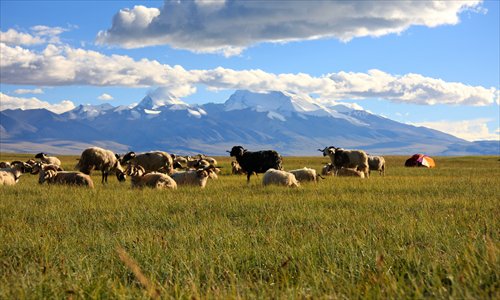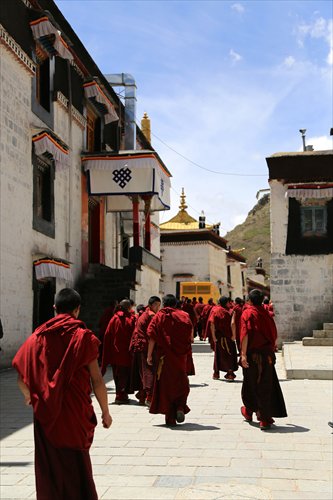

A flock of sheep and yaks walk by Lake Manasarovar in Ngari prefecture. Photo: Courtesy of Hu Wei

A group of monks visit Tashilhunpo Monastery at Shigatse, in the Tibet Autonomous Region. Photo: Courtesy of Hu Wei
Yang Guang stood on the mountain and looked carefully at his reflection in Lhamo La-tso Lake, a holy place in the Tibet Autonomous Region.
According to legend, if people stare at their reflection in this lake, they can see their past and future life stretched out before them.
So as he stood beside the lake, at an altitude of about 5,000 meters above sea level, Yang, 22, tried to catch a glimpse of his future.
"There were many Tibetans and monks around me. They were very pious and quiet. I think they may have understood the meanings of the reflections. My reflection looked different [than it normally looks] but I failed to understand it," recalled Yang.
"The lake was surrounded by mountains and it looked like it came from the sky," he said.
An employee at an IT company in Beijing, Yang has always dreamed of escaping from the polluted capital and fleeing to Tibet. His dream came true, at least temporarily, last summer as he traveled to the northern areas of southern Tibet, including the Zayu, Mainling and Lang counties.
The Xinhua News Agency reported in 2012 that China would invest 0.4 billion yuan ($65.4 million) to explore the tourism potential of the southeastern area of Tibet.
Tenzin Norbu, a Tibetan tour guide for 10 years, noted that new airports have been built and there have been more travelers, mostly Chinese, going to southern Tibet in recent years.
He added that the policy for foreign travelers has not loosened. Foreigners still need to get a Tibet Travel Permit to access southern parts of the region.
Unlike the high plateaus in northern Tibet, southern Tibet has a lower altitude and more diverse terrain including river valleys and basins. The unique scenery, the religious influences and the ethnic minority culture all make it stand out.
Turning the page
Traveler and writer Lei Diansheng, 41, took a long trip from northern Tibet region to the region's south way back in 2001. But he still remembers it clearly.
It was summer time when he walked to Shannan prefecture. Despite it being the warm season, rain and snow fell upon his shoulders. But then a gust of wind blew the clouds away and the sun emerged from hiding, revealing the snow-capped mountains.
There were green pine trees mingling with other yellow and red colors, and below the mountain there was a large area of grassland.
"The scene was like a three-dimensional painting. The beauty can take your breath away," Lei recalled.
Lei said he had to resort to using a cableway to cross the Yarlung Tsangpo River to enter into Mainling from Motuo county, as the only bridge there had been washed away by a flood.
"It's dangerous. But you can see less populated places," said Lei.
Lei also enjoyed communicating with ethnic minorities in the area.
"The Sherpa people living in Tibet look smaller in size [compared with those in Nepal]. Most of them living in Tibet can't speak Putonghua. The youth have often left for bigger places for work," Lei said.
Scenery of Lake Rakshastal in SW China‘s Tibet
2014-11-02Scenery of tidal wetland in China‘s Tibet
2014-10-30Wildlife protection in China‘s Tibet
2014-10-27Copyright ©1999-2018
Chinanews.com. All rights reserved.
Reproduction in whole or in part without permission is prohibited.